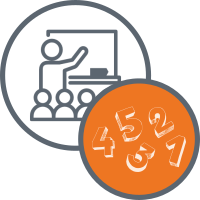You are here
Effective Mathematics Teaching Practice 2: Implement Tasks That Promote Reasoning and Problem Solving
Instructional Support Menu
Implement Tasks That Promote Reasoning and Problem Solving
Most of NCTM’s attention to task selection and implementation focuses on the cognitive demand of mathematical tasks (Smith & Stein, 1998). Tasks with low cognitive demand are those that simply require memorization or ask students to perform a procedure without connecting that procedure to something that reveals deeper conceptual understanding. Tasks with high cognitive demand are those that don’t give a procedure to follow, thus requiring students to develop their own, or a given procedure includes requirements to connect the procedure to conceptual understanding.
Research has shown us that students in the United States either (a) lack access to high cognitive demand tasks (cite Teaching Gap, QUASAR) and (b) when given high cognitive demand tasks, teachers often lower the demand of tasks through the use of hints and unnecessary support (cite QUASAR, etc.). While students aren’t expected to only engage with high-demand tasks, regular opportunities to engage in high-demand tasks is associated with stronger achievement in mathematics (Stein & Lane, 1996). This requires teachers to have a well-trained eye for selecting materials. Online resources such as lesson and task repositories give teachers many sources to choose from, but a poor choice of task may not align well with standards, interrupt the learning progression and design of curricular units, and lead to less learning overall (Larson, 2016).
Effective teaching of mathematics engages students in solving and discussing tasks that promote mathematical reasoning and problem solving and allow multiple entry points and varied solution strategies.
-NCTM (2014), p. 17
The Practice in Action
One of the ways NCTM (2014, p. 24) summarizes the practice of implement tasks that promote reasoning and problem solving is by describing a set of actions expected of teachers and students that indicate engagement in this teaching practice.
Caution! Don't over-estimate your own understanding based on these brief descriptions of teaching practice. Professional educators should dig more deeply into NCTM's resources, join study groups and professional networks, and seek out professional development and coaching to ensure high-quality engagement in the practice.
What are teachers doing?
- Motivating students’ learning of mathematics through opportunities for exploring and solving problems that build on and extend their current mathematical understanding.
- Selecting tasks that provide multiple entry points through the use of varied tools and representations.
- Posing tasks on a regular basis that require a high level of cognitive demand.
- Supporting students in exploring tasks without taking over student thinking.
- Encouraging students to use varied approaches and strategies to make sense of and solve tasks.
What are students doing?
- Persevering in exploring and reasoning through tasks.
- Taking responsibility for making sense of tasks by drawing on and making connections with their prior understanding and ideas.
- Using tools and representations as needed to support their thinking and problem solving.
- Accepting and expecting that their classmates will use a variety of solution approaches and that they will discuss and justify their strategies to one another.
Resources
- Principles to Action: Ensuring Mathematical Success for All (NCTM, 2014, pp. 17-24)
- Taking Action: Implementing Effective Mathematics Teaching Practices in K-Grade 5 (NCTM, 2017, pp. 37-66)
- Taking Action: Implementing Effective Mathematics Teaching Practices in Grades 6-8 (NCTM, 2017, pp. 29-54)
- Taking Action: Implementing Effective Mathematics Teaching Practices in Grades 9-12 (NCTM, 2017, pp. 29-48)
- Enhancing Classroom Practice with Research behind Principles to Actions (NCTM, 2017, pp. 13-26)
- Catalyzing Change in Middle School Mathematics (NCTM, 2020, p. 59)
- Selecting and Creating Mathematical Tasks: From Research to Practice (Smith & Stein, 1998)
- Instructional Tasks and the Development of Student Capacity to Think and Reason: An Analysis of the Relationship between Teaching and Learning in a Reform Mathematics Project (Stein & Lane, 1996)
- Curricular Coherence in the Age of Open Educational Resources (Larson, 2016)




Connect With Us





